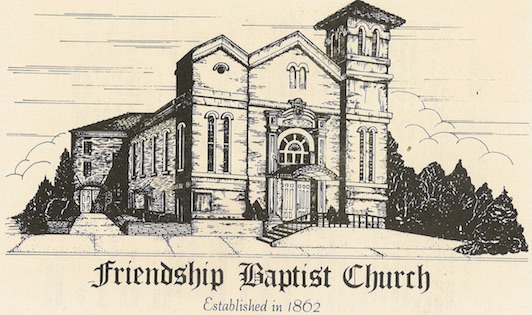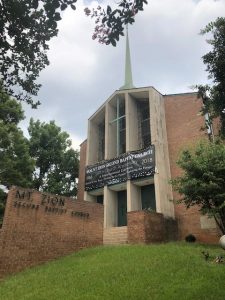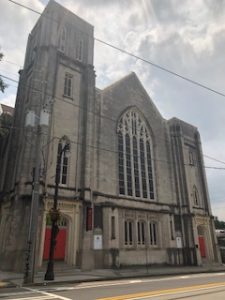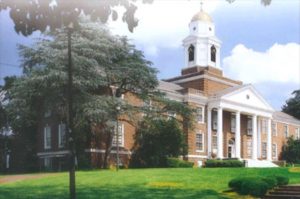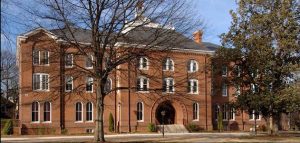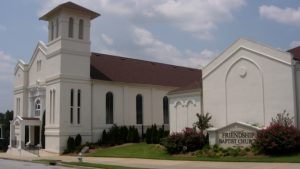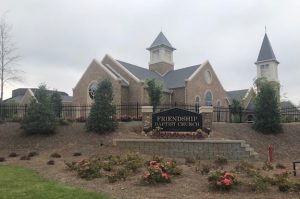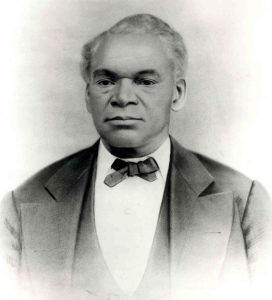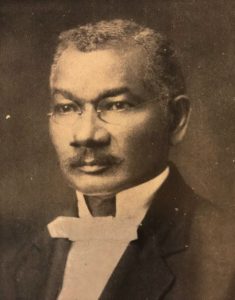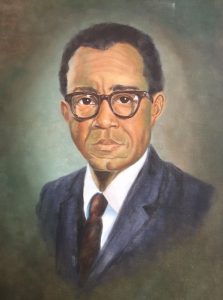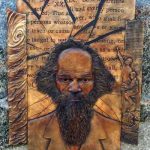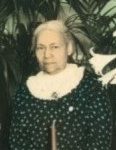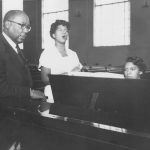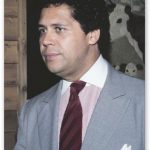This narrative showcase was prepared in collaboration with Ann Dennard Pope,
Director of Archives, Friendship Baptist Church. Photo courtesy of Communities Who Know, Inc.
A Short History
[perfectpullquote align=”right” bordertop=”false” cite=”” link=”” color=”#857437″ class=”ppq” size=”12″]The Ponder House was the Atlanta residence of Ephraim G. Ponder, a South Georgia planter and slave trader. Built in 1857, it was on one of the highest points overlooking the city. With the approach of Union forces to Atlanta in 1864, it served as a key fortification for the Confederates, thus becoming one of the first structures to be bombarded in the siege of Atlanta.[/perfectpullquote]
In 1862, with the American Civil War well underway, twenty-five enslaved African Americans received permission from their white slave owners to establish their own independent church. Several among this group, including the first pastor of the congregation, Reverend Frank Quarles (1819-1881), were enslaved at the Ponder House. This core group of worshippers became the first autonomous African American Baptist congregation in the City of Atlanta. It was an important milestone that resulted from a commitment to worship that took root much earlier in 1848, again with the permission of the white slave owners, when a small group was approved to attend the white First Baptist Church.
[perfectpullquote align=”right” bordertop=”false” cite=”” link=”” color=”#857437″ class=”ppq” size=”12″]Edmund Asa Ware was a northern activist educator from Connecticut, a graduate of Yale University, who was appointed Superintendent of Schools in 1866 for the Atlanta District of the American Missionary Association. He became the first president of Atlanta University, serving from 1869-1885.[/perfectpullquote]
Securing their autonomy as an independent congregation, however, launched a new era of spiritual and community achievements that would also secure a place of honor for the Friendship group in local and national history. The first official meeting place for the young church was a boxcar. With the advocacy of Edmund Asa Ware, the box car was purchased in Chattanooga, Tennessee, and sent to Friendship by the Ninth Street Baptist Church of Cincinnati, Ohio. With the collaboration of Ware and Quarles, the modest space of the boxcar served two purposes: as a school (that ultimately became Atlanta University) and as meeting space for the Friendship Church congregation.
In 1870, the fast growing congregation completed a new building on the corner of Haynes and Markham Streets, which they also quickly outgrew. In 1871, they began construction of a new building at 437 Mitchell Street that was completed in 1872.
Under the leadership of Rev. Quarles, Friendship experienced an era of exponential growth, so much so in fact that it became “mother” to nine other Baptist congregations across the city, including two that were founded on the East side of Atlanta soon after Friendship’s own founding: Mt. Zion Second Baptist Church in 1868 and Wheat Street Baptist Church in 1869.
During this post-Civil War era, Friendship also became a launching pad for educational opportunity, in providing spaces to convene for a university and two colleges. These institutions were the first institutions of higher education in the City of Atlanta: Atlanta University; Morehouse College; and Spelman College.
Each of the three buildings in this set is the oldest building on its current campus.
[perfectpullquote align=”right” bordertop=”false” cite=”” link=”” color=”#857437″ class=”ppq” size=”12″]Atlanta University was founded in 1866 and shared space with Friendship in the box car. Morehouse College was founded in 1867 in Augusta, Georgia as the Augusta Institute. The Institute re-located to Atlanta in 1879 and was re-named the Atlanta Baptist College until 1913 when it became Morehouse College. The college’s first classes were held at Friendship. Spelman College was founded in 1881 as the Atlanta Baptist Female Seminary in the Friendship basement with the vision, insight, and fundraising efforts of Rev. Quarles, the Friendship community and friends. The name was changed to Spelman Seminary in 1884 and then Spelman College in 1924.[/perfectpullquote]
The Mitchell Street building stood for 143 years as the beautiful and iconic Friendship Baptist Church, bearing witness over the decades to an amazingly long list of historical moments for Atlanta, the nation, and the world, all of which signaled evolving social, political, cultural change. Examples include:
- Atlanta’s Cotton States and International Exposition (1895), where Booker T. Washington (African American educator and socio-political leader) gave his infamous Atlanta Compromise Speech in which he supported industrial education (instead of focusing on intellectual development) for African Americans and accepted separate social horizons for the races.
- The hiring of William E. B. DuBois (Harvard educated sociologist, philosopher, and advocate for intellectual and leadership development for African Americans) by Atlanta University as one of the first African American professors on faculty. Dubois served from1897-1910 and again from 1934-1944. While teaching at Atlanta University, DuBois completed The Philadelphia Negro (1899); his most widely acclaimed volume, The Souls of Black Folk (1903); and several additional significant studies on African American culture, along with his founding also of the scholarly journal Phylon in 1940.
- The Atlanta race riots (September 22-24, 1906), organized by whites to suppress the growing presence and prosperity of African American communities in Atlanta.
- Two world wars and a steady stream of other military conflicts that now serve as watermarks in the ongoing evolution of globalization processes.
- The Modern Civil Rights Movement, which changed the trajectory of human and civil rights and the exercising of social justice in the United States and beyond.
- Men and women traveling beyond the earth into outer space, creating a broader scope and context for understanding the human enterprise and a vibrant springboard for a broad range of innovative developments in science and technology.
- The coming of professional sports to Atlanta (baseball, football, basketball, soccer), leveraging along with other initiatives and innovations the identity of Atlanta as a major urban center nationally and internationally.
- A son of Friendship, Maynard Holbrook Jackson, Jr. becoming the first African American Mayor of the city (1974-1982 and 1990-1994), helping to set the leading edge for a new era in political leadership by African Americans, locally and nationally.
- Barack Obama being elected in 2012 the first African American to become President of the United States, ushering in a potential for human relationships and civic participation in the United States that defies longstanding boundaries of traditional practice and social imagination.
- So much more.
Within this context of development and change, Friendship’s mission as a Christian community has continued, with the congregation carrying forward with distinction its ever-evolving work.
On September 22, 2013, amid a multi-layered environment of emotions, Friendship Baptist Church agreed to sell their historic home site to the Atlanta Falcons football team to make way for the Falcon’s new Mercedez-Benz Stadium. The church held their last service on Mitchell Street on May 25, 2014, with Rev. Dr. William V. Guy, Pastor Emeritus, delivering the sermon. Rev. Guy acknowledged the deep nostalgia that comes with the Mitchell site being home for so many decades, the even deeper sadness at the demolition of a home to which they will not be able to return, and also the challenges that come with change. He emphasized, however, that the church, the community, the people have their physical and spiritual strength. They have the passion of their convictions. They will continue to endure and to sustain their commitments to community, community leadership, and civic engagement —and so they have. While a new sanctuary was under construction at their new site at 80 Walnut Street, the congregation held temporary services at Morehouse College in the Martin Luther King, Jr. Chapel. Two years later, with construction completed, Friendship held its first worship service at its new site on July 30, 2017.
Key Actors
The Pastors
In its long history, there have been seven pastors of Friendship:
- Father Quarles (1862-1881)
- Rev. Dr. Edward Randolph Carter (1882-1944)
- Rev. Dr. Maynard Holbrook Jackson (1945-1953)
- Rev. Dr. Samuel Woodrow Williams (1954-1970)
- Rev. Dr. William Vincent Guy (1971-2007)
- Rev. Dr. Timothy T. Boddie (2008-2012)
- Rev. Dr. Richard W. Wills, Sr. (2015-Present).
The Members
The members of Friendship have been equally active in making contributions that have mattered to their congregation, the City of Atlanta, and beyond. Examples of notable leaders among the congregation are abundant, with their achievements occurring in a full range of arenas of action from the early days forward, including:
Business and Entrepreneurship – Even during the post-Civil War early days, this group of leaders included tailors, dressmakers, milliners, barbers, brick masons, entrepreneurs, and more. One example is James Tate, who was born a slave in Elbert County, Georgia. Tate came to Atlanta in the 1860s; opened two grocery stores where he did a thriving business on Walnut Street and on Decatur Street; became one of the first highly successful African American businessmen in the city; and was a leading advocate and organizer for educational advancement in the African American community. Regarded as the “Father of Black Business in Atlanta,” a bronze relief sculpture of him was erected on Auburn Avenue in 1996.
Community Organization and Development – A striking example was Obedia Cecile Brown Carter, spouse of Reverend Edward Randolph Carter. Her roles included: President of the West Atlanta Woman’s Christian Temperance Union, Treasurer of the State Woman’s Christian Temperance Union, and leader of several church-led community activities.
Education – There is a very long list of members who excelled as teachers and school administrators and others who excelled as professors and administrators in colleges and universities. One example was Dr. Willis Laurence James, distinguished musicologist and composer. A graduate of Morehouse College (1923), he completed further studies at the prestigious Chicago Musical College (now a division of the Chicago College of Performing Arts at Roosevelt Universtiy). He served as professor of music, chair of the Department of Music, and director of the Spelman College Glee Club from 1933 – 1966.
Politics – A striking example of the prominence of the members of Friendship in politics, as indicated earlier, is Maynard Holbrook Jackson, Jr., son of Rev. Dr. Maynard H. Jackson, Sr., the third pastor of Friendship. Jackson, Jr. was the first African American to serve as a mayor of a major southern city, serving a total of three terms: consecutive terms from 1974–1982 and a third term from 1990-1994.
Living Legacies
Rev. Dr. Richard Wills, Sr., the current pastor, spoke eloquently in the Friendship podcast that is linked to this narrative about the path ahead for Friendship, emphasizing that their response to challenges ahead is shaped by the very essence of who they are as a church family. He stated that their challenge is to “lean into the meaning of their name,” extending the embrace of friendship around their own membership and beyond. The new church site continues to be an iconic beacon on the Atlanta landscape for family, community, Christian spirit, and civic leadership. The ongoing legacies are manifold in terms of the missions that they uphold, but one longstanding mission stands out given this reflective showcase. In their new site, Friendship follows boldly and innovatively in the footsteps of Rev. Dr. Edward R. Carter, their second pastor. In 1894, Rev. Carter documented and preserved the history and distinctive accomplishments of African Americans in the City of Atlanta from its founding in a volume entitled The Black Side, A Partial History of the Business, Religious and Educational Side of the Negro in Atlanta, GA.
In 2017, Friendship included in their new space a Museum and Archives. With the leadership of Ann Dennard Pope (herself a member of a third generation Friendship family), the church is partnering with Communities Who Know, Inc. (a non-profit organization focused on community development and sustainability) to host workshops at Friendship to help community members to build knowledge and experience about ways to preserve the various materials from their families and organizations. The goal of the preservation initiatives is an important one: to document, preserve, present, and make available to others the ongoing story of the lives, history, and culture of the community, showcasing, as Rev. Dr. Carter sought to do, the fullness of the Atlanta story.
Selected References
- Antoinin, Henrietta Phillips. “Personal Interview.” 26 June 2018.
- Atlanta Public Schools – Forgotten Treasures.” https://apsforgotten.wordpress.com/
- Auburn Avenue Research Library on African American Culture and History. Atlanta-Fulton Public Library System. Atlanta, Georgia.
- Blackburn, Willie Dobbs. One Hundred Twenty-Fifth Anniversary Celebration: Friendship Baptist Church. Atlanta: Friendship Baptist Church, 1989.
- Carter, Edward R. The Black Side, A Partial History of the Business, Religious and Educational Side of the Negro in Atlanta, GA. 1894. London: Forgotten Books, 2017.
- Cole, Thomas W., Jr. Clark Atlanta University: Charting a Bold New Future. Bloomington, IN: AuthorHouse, 2013.
- Dennard, Ann Pope. “Personal Interview.” 2 February 2018.
- Friendship Baptist Church Archives, Atlanta, Georgia.
- Jones, Edward A. Candle in the Dark: A History of Morehouse College. King of Prussia, PA: Judson P, 1967.
- Mason, Herman, Jr. Black Atlanta in the Roaring Twenties. Charleston: Arcadia P, 1997.
- New Georgia Encyclopedia. http://www.georgiaencyclopedia.org.
- Read, Florence Matilda. The Story of Spelman. Atlanta: Spelman College, 1961.
- Saporta, Maria. “Friendship Baptist Church’s Last Service Filled with Sadness, Nostalgia As Well As Hope for the Future.” Saporta Report. 25 May 2014. https://saportareport.com/friendships-last-service-filled-with-sadness-nostalgia-with-hope-for-the-future/. 28 July 2018.
- Spelman College Archives, Atlanta, Georgia.
- Wills, Rev. Dr. Richard W. Sr. “Personal Interview.” 14 December 2017.
Credits
- Author: Jacqueline Jones Royster, Dean, Ivan Allen College of Liberal Arts
- Contributing Author: Ann Dennard Pope, Friendship Baptist Church
- Building Memories Project Team:
- Jacqueline Jones Royster, Executive Producer
- Steve Hodges, Project Manager
- Gene Kansas, Co-producer, Building Memories Podcast
- Stephen Key, Co-producer, Building Memories Podcast
- Interns: Charles A. Cardot, Maura F. Currie, Prachi Mehta
Community Partners
We are grateful for the partnership on this episode of:
Friendship Baptist Church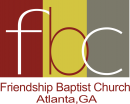
Constellations

